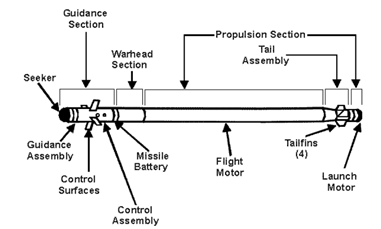Reading Activity
The Stinger weapon system is a man portable (34.5 pounds), shoulder-fired, supersonic missile system designed to counter high-speed, low-level, ground attack aircraft. Stinger is effective against helicopters, unmanned aerial vehicles, and observation and transport aircraft. Once fired, Stinger uses proportional navigation
algorithms to guide the missile to a predicted intercept point. The Stinger missile can be used as a man portable air defense system (MANPAD) when the weapon is fired from the gunner’s shoulder, mounted aboard the Avenger weapons system, or mounted in the light armored vehicle-air defense variant (LAV-AD).
Stinger reprogrammable microprocessor (RMP) (the Stinger missile’s most recent variant) is a dual-channel, passive infrared (IR) and ultraviolet (UV) tracking seeker and proportional navigational guidance missile system. The spectral discrimination of the seeker detector material, when supercooled by the argon gas in the battery coolant unit, enables Stinger to acquire, track, and engage targets in any aspect (incoming, outgoing, or crossing). Stinger is a true “fire and forget” missile, requiring no inputs from the gunner once the weapon is fired. This allows the gunner to take cover, move to an alternate position, or engage additional targets. Stinger also possesses an integral identification, friend or foe (IFF) subsystem to assist the gunner in identifying friendly aircraft. The Stinger missile is comprised of the guidance, tail, propulsion, and warhead sections. The tail assembly consists of four folding tail fins that provide roll and stability while the missile is in flight (Figure 1).

The guidance section consists of a seeker assembly, a guidance assembly, a control assembly, a missile battery, and four control surfaces (or wings) that provide in-flight manoeuvrability.
The warhead section consists of a fuze assembly and the equivalent of one pound of high explosives encased in a pyrophoric titanium cylinder. The fuze is extremely safe and makes the missile exempt from any hazards of electromagnetic radiation to ordnance conditions. The warhead can be detonated by penetrating the target, impacting the target, or self-destruction. Self-destruction occurs 15 to 19 seconds after launch.
The propulsion section consists of a launch motor and a dual-thrust flight motor. The launch motor ejects the missile from the launch tube. The missile coasts a safe distance (about 9 meters) from the gunner before the dual thrust flight motor ignites and provides a sustained 22 gravity acceleration that arms the missile. After the gunner arms the missile, a sustained flight phase maintains missile velocity until the propellant is consumed. Then the missile enters a free flight period in which the motor has burned out, but the missile maintains a degree of maneuverability prior to interception or selfdestruction.